Peperomia Plants (Radiator Plants): Care, Types, Toxicity and More
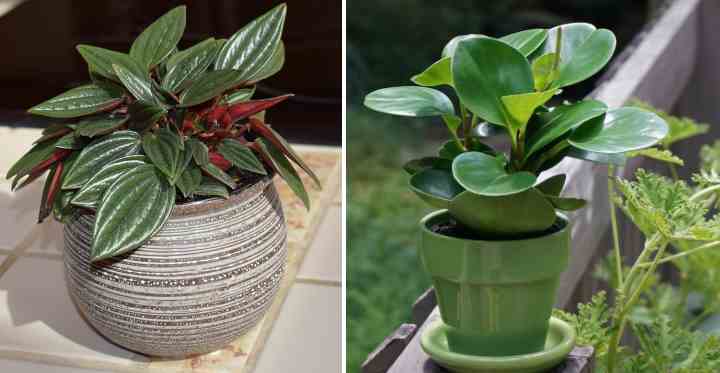
Peperomia is a type of tropical plant that is easy to grow indoors. Peperomia plants (also called radiator plants) are well suited for growing as a beautiful lush houseplant. Many peperomia species have attractive foliage with glossy leaves that come in all shapes and sizes. Some of the ornamental peperomias have a compact look with bright variegated leaves. From the more than 1,500 varieties of peperomia, there is definitely a species that suits your home or office.
How to care for peperomia: the radiator plant thrives when growing in well-draining potting soil, getting plenty indirect light, and watered when the top layer of the soil in the container is dry. Most plants don’t need high humidity and grow well in average room temperature of 65°F to 75°F (18°C – 24°C). You only need to feed the slow growing houseplant once every couple of months during the growing season.
This peperomia care guide contains all you need to know about how to care for this popular, easy-to-grow houseplant. You will also learn about some of the most popular types of radiator plants, such as the peperomia watermelon.
About Peperomia
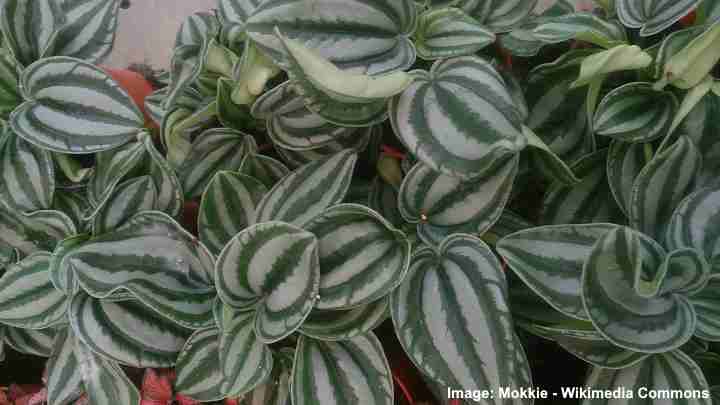
Peperomia (radiator) plants include many cultivars. In the picture: watermelon peperomia (Peperomia argyreia)
Peperomias are leafy plants that belong to the plant family Piperaceae. The plant species are native to Central and South America, where they thrive in warm, humid conditions. Most types of peperomias “radiator plants” are compact perennials with ornamental foliage. It is this lush green foliage which makes peperomias attractive indoor plants.
As an indoor houseplant, peperomia plants don’t grow more than 12” (30 cm) high. The smaller varieties may only grow as high as 6” (15 cm). Some species are more compact than others, and some types have a bushier appearance. There are also peperomias with trailing stems that make attractive hanging baskets.
One of the interesting features of peperomias is their variation in look. Different species have heart-shaped fleshy leaves, lanceolate leaves, or oval leaves. Some types of leaves have fascinating patterns. For example, the watermelon peperomia has patterns that look like watermelon skin. Others have deep veins, stripes, variegated blotchy patterns, or plain shiny green colors.
Radiator Plant
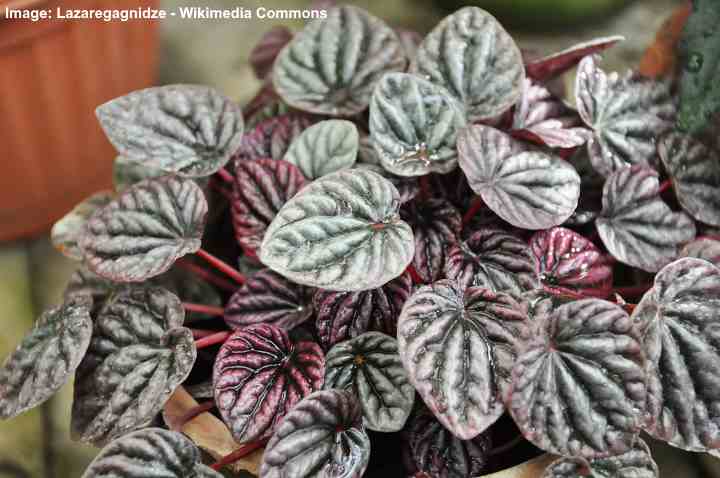
Peperomia caperata ‘Emerald Ripple Red’ has green and purple textured leaves
The radiator plant is another name for peperomias. The common name “radiator plant” seems to come from the fact they like warm air and sunlight. These common houseplants like growing near heat sources and can withstand dry and damp conditions.
All types of radiator plants (peperomias) are known for their varied appearance. To keep the foliage lush and healthy, radiator plants only need medium to full sunlight and watering every so often.
Peperomia Types: Varieties of Peperomia Plant

Peperomia caperata ‘Rosso’ has green textures leaves which are reddish brown underside
There are too many types of peperomias to list in this article. Here are some of the most popular varieties of peperomia plants (radiator plants).
- Peperomia Obtusifolia or Baby Rubber Plant. This is a succulent-like type of peperomia that has upright stems and large glossy green leaves.
- Peperomia Rotundifolia or Trailing jade. Also known as round leaf peperomia, this is a trailing type of peperomia with small, thick and fleshy leaves .
- Watermelon Peperomia (Peperomia argyreia). This popular indoor peperomia plant has bright green oval leaves with dark green stripes. The patterns make the leaves look like the rind of a watermelon.
- Beetle Peperomia (Peperomia quadrangularis). With its trailing stems and dark-green striped ovate leaves, this peperomia looks excellent as a hanging basket.
- Rainbow Peperomia (Peperomia clusiifolia). This delightful peperomia has elongated leaves that have cream-colored edges and light pink blushing.
- Columbian Peperomia (Peperomia metallica). With its striking red and silver foliage and small leaves, this bushy compact house plant will brighten up any room.
- Peperomia Perciliata (Peperomia perciliata). This easy-growing attractive houseplant has thick succulent-like green leaves and red stems. This peperomia grows well in terrariums, in hanging baskets, or bright sunny places.
- Red Ripple Peperomia (Peperomia caperata). The stunning reddish-purple leaves have deep veins giving the leaves a bumpy texture.
- Peperomia marble (Peperomia obtusifolia ‘Marble’). This radiator plant has spoon-shaped variegated leaves that are bright green and yellow.
- Peperomia Caperata Rosso (Peperomia caperata). Also called the Emerald Ripple Radiator Plant, this attractive radiator plant has glossy green leaves with striking red undersides.
Peperomia Plant Toxicity to Cats and Dogs
Peperomias aren’t toxic to pets (such as cats and dogs) or humans.
Peperomia Care Guide
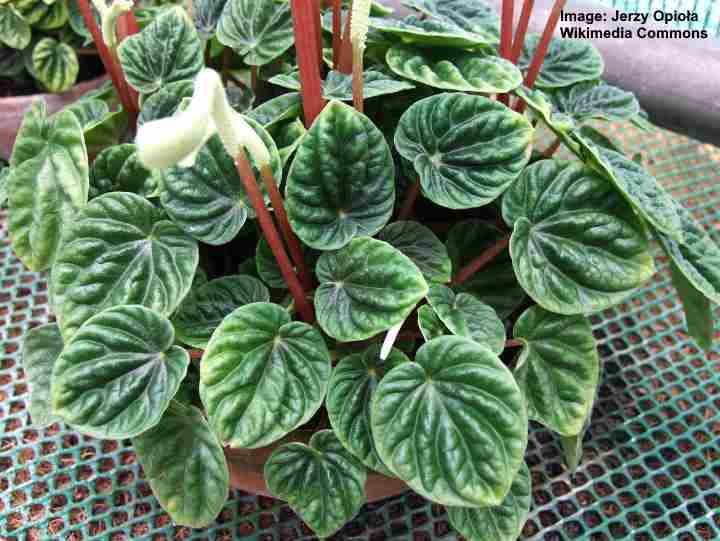
Peperomia caperata is a type of radiator plant with glossy green leaves
Peperomias are on the list of easy-to-care-for houseplants. To ensure that your specimen grows healthy and produces lush leaves, you should remember a few things.
Let’s look in more detail at how to care for peperomia or radiator plants.
Peperomia (Radiator Plant) Light Requirements

Peperomia clusiifolia`Jeli` is a type of variegated peperomia
Peperomias thrive when they get plenty of indirect sunlight or grow in bright places. Getting enough light ensures that your radiator plant produces vibrant foliage that looks healthy.
The ideal location to place your peperomia is on an east or west-facing windowsill. If there is a lot of direct sunlight, you could keep the plant behind sheer curtains. Because peperomias are low-light plants, they also grow well in offices where there is fluorescent lighting.
One of the reasons why many peperomia species are so popular is that they also tolerate low-light conditions. Thus, a peperomia plant growing in a container in a north-facing room or dark room can be the ideal houseplant. You may find that your peperomia becomes leggy if the light is insufficient. Later in the article, you will find top tips on pruning your peperomia to keep its attractive appearance.
To prevent yellow leaves on your peperomia, keep the plant away from strong, direct sunlight. These shady conditions help to create an environment similar to their natural habitat. Radiator plants are tropical plants that grow in rainforests, where direct sunlight is minimal.
Best Soil for Peperomia Plants
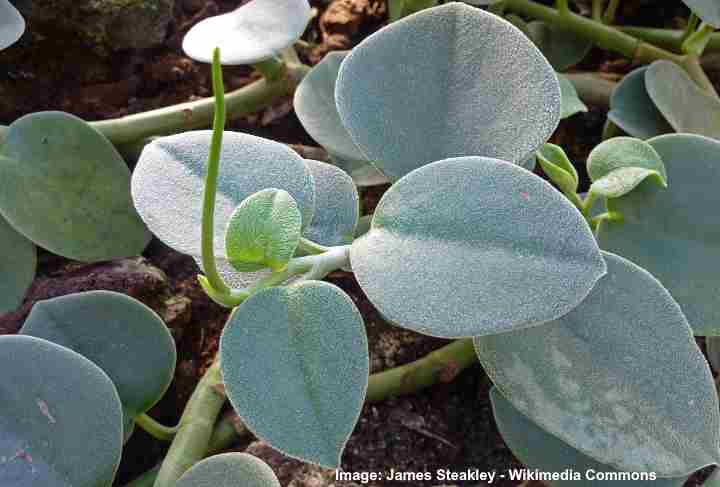
Peperomia incana is a trailing peperomia with felt-like textured leaves which will also look good in hanging basket
The essential soil requirement for peperomia plants is to make sure it drains well. Well-draining potting soil helps keep peperomia foliage looking glossy, vibrant, and healthy.
Regular potting mix that has peat and perlite helps to ensure proper soil moisture levels. Loamy soil allows excess water to drain through to prevent root rot and yellowing leaves.
How Often to Water a Peperomia Plant
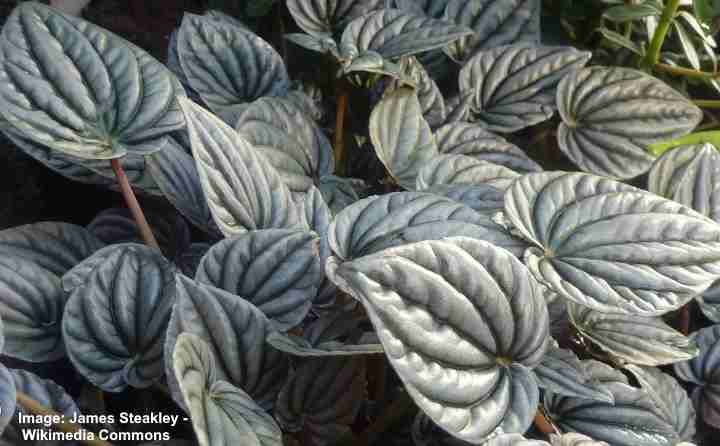
Peperomia griseoargentea has silvery-green rippled leaves
Peperomias are an easy-to-care-for house plant because they don’t need much watering. They are very forgiving if you forget to water them frequently enough.
How do you know when to water your peperomia? As a rule of thumb, wait until the top 1” – 2” (2.5 – 5 cm) layer of the soil in the container is dry. Water the soil thoroughly until the water drains out the bottom. Remember to check soil dryness every week or so. The frequency of watering depends greatly on your room temperature.
A common problem when it comes to watering a peperomia plant is too much water. Unlike nerve plants that need moist soil to grow, peperomias need the soil to dry out partially. Avoid watering your peperomia if the top layer of soil is still damp. Also, don’t keep your container sitting in a saucer of water as this can cause root rot.
Other signs of too much water are yellowing leaves, wilting stems, or rotting stalks. If you notice your plant wilting and the soil is damp, hold off watering until the top soil is dry.
The Right Temperature for Peperomia
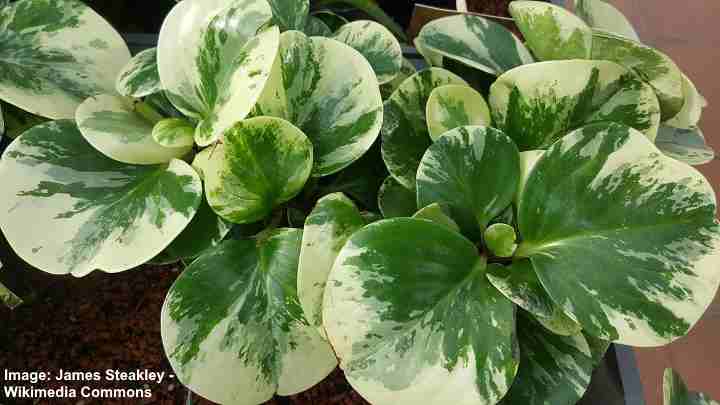
Peperomia obtusifolia ‘Variegata’ has green and white-cream marbled leaves
Average room temperature is the right environment for your peperomias to thrive. The ideal temperature range is between 65 and 75°F (18 – 24°C). Remember that peperomias come from tropical and subtropical climates and will die in cold temperatures.
The absolute minimum temperature that peperomias withstand is 50°F (10°C). For this reason, most people keep peperomias as houseplants and don’t grow them outdoors.
To care properly for your peperomia, you should avoid sudden changes in temperature. It is best to keep them away from drafts. Also, if you buy peperomias from a garden center in winter, protect them from the cold when you transport them home.
Humidity Requirements for Peperomias
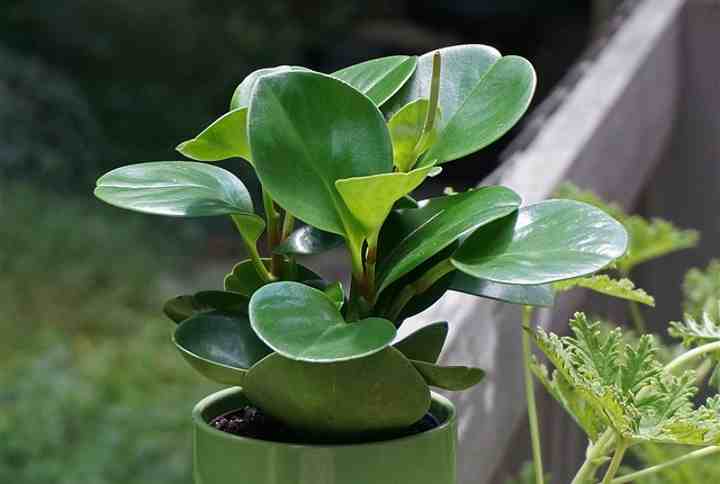
Peperomia obtusifolia has glossy smooth green leaves
Most species of peperomias don’t need high humidity to thrive in indoor environments. Peperomias have succulent type leaves that can store moisture. However, some peperomia varieties need high humidity.
The thickness of the leaves is the best way to gauge how much humidity your houseplant needs. If the plant has thin leaves, then you will need to mist them regularly to keep up moisture levels. Another way to increase humidity is to sit the container on a pebble tray that has water in it.
Misting and keeping up humidity levels is essential when household heating is on. Central heating tends to dry out the air which can then affect your plant growth.
How to Fertilize Peperomia Plants

In the picture: peperomia orba`Variegata`
Because peperomias are small, slow-growing houseplants, they don’t need much fertilizer. Usually, soil that is rich in organic matter provides enough nutrients for healthy growth.
One of the mistakes when caring for a radiator plant is using too much fertilizer. So, when it comes to feeding, less is better for peperomias.
If you need to add some fertilizer, use a liquid fertilizer for houseplants. You only need to feed the leafy houseplant once every couple of months during the growing season.
One care tip to treat your indoor peperomia properly is to flush out fertilizer between feedings. This helps prevent a buildup of mineral salts that can cause it to drop its leaves and develop other growing problems.
You usually find that peperomias grow just fine without any additional fertilizer. These easy indoor plants only need enough sunlight and occasional watering to grow well.
Repotting Your Peperomia

Peperomia rotundifolia (Trailing Jade) has green round and fleshy leaves
Peperomia houseplants have modest care requirements when it comes to repotting them. Because they grow slowly, they only need repotting every three years or so. In fact, peperomias seems to grow better in containers that are slightly too small for them.
Repotting your peperomia every few years has its advantages if you want to care for them properly. Transferring to a larger pot and changing the soil helps to provide enough nutrients for the plant. Also, repotting helps to improve drainage and makes it easier to care for your houseplant.
Repotting can also help revive a peperomia if you think that your plant is dying due to overwatering.
To repot your plant, carefully remove it from the container and shake off excess soil. If the soil is excessively damp, try to get rid of as much of it as you can. Check the roots and prune off any that are damaged or diseased. Repot the plant in a new container with loamy, peat-based potting soil.
After repotting your peperomia, it is essential to care for it properly. So, follow the watering tips that are mentioned in this article.
Peperomia Propagation
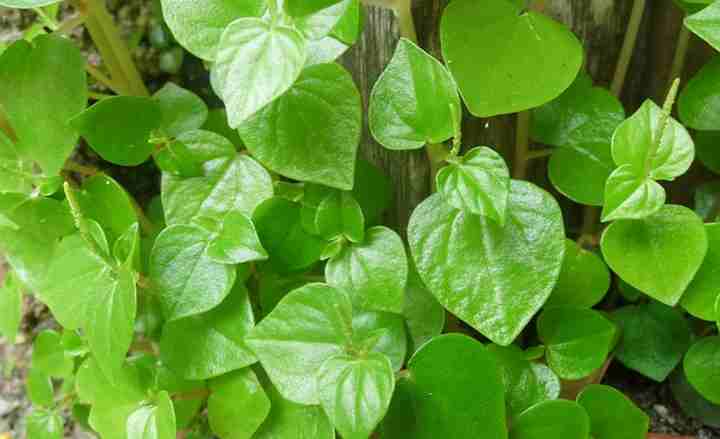
Peperomia pellucida has bright green foliage
Peperomias are just as easy to propagate as they are to care for. You can quickly grow more of these delightful houseplants as gifts for family or friends.
Peperomia propagation is usually done by stem cuttings or leaf cuttings in springtime or early summer. Here are the best tips to propagate your healthy peperomia plant.
How to propagate peperomia from stem cuttings
Propagating peperomias from stem cuttings is best for trailing or tall upright types of plants.
Cut the stem just below the third pair of leaves from the top. Remove the bottom two leaves and dip the end of the stem in some rooting powder. Put the cutting into a small container that has potting mix and thoroughly water the soil.
An alternative method is to put the cutting in a small glass of water. Depending on the species, roots should appear from around 2 – 3 weeks. Transfer to a small pot containing potting soil.
Ensure that while taking root in the soil, the cutting is kept warm and moist. It should take about four weeks for roots to form properly and start growing.
How to propagate peperomia from leaf cuttings
If you have a bushy peperomia, it is usually more practical to propagate from leaf cuttings. The stems on bushy peperomias tend to be too soft, and they rot quicker.
To grow more peperomias from leaf cuttings, you should cut off a healthy leaf where it attaches to the stem. Trim the leaf stem, so that it has a diagonal cut. Then, make a small hole in potting soil and carefully insert the leaf cutting. Press the soil around the stem and gently water. As with stem cuttings, keep the propagated peperomia warm and moist until new growth starts to appear.
How to Prune a Peperomia for Healthy Growth

Peperomia orba has smooth glossy green leaves
Radiator plants are excellent for novice and experienced plant lovers as they are easy to grow and prune. Pruning peperomias helps to give them a bushier appearance and preserve their ornamental look. Pinching off dead or yellow leaves also helps keep your peperomia healthy.
The best time to prune back your peperomia is in spring. All you have to do is pinch off the ends of stems to remove the first set of leaves. Cutting back the stems promotes bushy growth. This annual houseplant pruning is the best way to prevent the plant from becoming leggy.
Peperomia Flowers
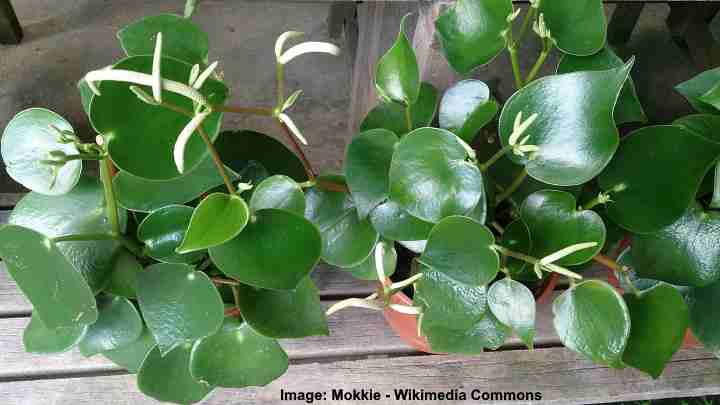
Peperomia polybotrya ‘Jayde’
Peperomias are a type of flowering tropical houseplant that produces flowering stems. The green or pink stems are not showy and don’t add much to the beauty of the lush peperomia foliage.
Some say that peperomia flowers look like vertical pink rat’s tails with tiny flowers on it. The flowering stems may only be 2” or 3” (5 – 7.5 cm) tall. The unimpressive flowers don’t have any scent.
The one good thing about flowers on a peperomia plant is that they are a sign of healthy growth. If you care and treat your radiator plant well, you will get rewarded with flowers in late summer or early fall.
Peperomia Pests and Diseases

Peperomia rubella has red-purple stems with green foliage
Fungal diseases, gnats, mites, and mealybugs can affect peperomia plants. Most of these issues can be resolved with proper watering and care.
Let’s look at a few of these reasons why your peperomia looks like it is dying.
Signs of peperomia diseases
Fungal infections such as Pythium can kill off peperomias by causing the roots to rot. Signs of waterlogged soil that result in diseased roots are wilting leaves and black spots on stems.
To help bring a dying peperomia plant back to life, repot it and remove as many of the damaged roots as possible.
Black leaf spots could be due to infectious diseases such as Cercospora, Rhizoctonia, or Phyllosticta. If you notice black leaf spots, isolate the plant from other houseplants. Prune off all the diseased foliage and then discard it. Be sure to sterilize your pruning scissors before and after pruning to prevent spreading infections.
Yellowing leaves on a radiator (peperomia) plant
The most common reasons for peperomia leaves turning yellow are watering, lighting, or temperature issues.
Peperomias can tolerate direct sunlight, but not for extended periods. Make sure that you don’t have them in on a south-facing windowsill. Usually, moving the plant to a bright yet shady location helps to bring color back to the leaves.
If the soil feels waterlogged, hold back watering until the top layer of soil dries out. If this doesn’t help revive a poor-looking plant, try repotting it to reduce soil moisture and prune damaged roots.
The best way to care for your peperomia is to keep it in a warm environment. So, if you’ve noticed wilting, yellowing leaves, make sure that no drafts are affecting the plant.
Signs of peperomia pests
Stunted growth, mold under leaves, or small black flies from the soil are signs of pests. Sometimes, reducing watering can be enough to control fungus gnats.
If you notice mealybugs that look like white bugs, use a natural neem oil insecticidal spray to remove them. You can also try insecticidal soap to help get rid of mites and mealybugs.
Fortunately, peperomias are easy plants to care for, and they are not prone to pest and disease infections.
Related articles:
